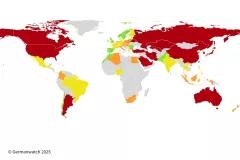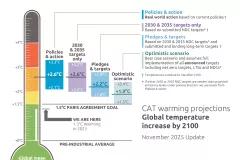Individual national contributions (NDCs) to the Paris Agreement to reduce greenhouse gas emissions will need to be strengthened in order to limit future climate change to “well below” 2°C and “pursuing efforts” to limit it to 1.5°C, according to a new assessment.
Pledges made for the Paris Agreement on climate change last winter would lead to global temperature rise of 2.6 to 3.1°C by the end of the century, according to a new analysis published in the journal Nature. The publication in Nature is a meta-analysis prepared by an international team covering ten independent studies, including for the first time also the UNFCCC synthesis report. The paper originated from the UNEP emissions gap report, which compares a number of studies on the projected impact of current climate mitigation efforts, one of which is the Climate Action Tracker.
What is new? Already when the Paris Agreement was adopted in December, it was clear that national contributions need to be strengthened to be in line with the agreed long-term goals. So what is new in the Nature paper?
The estimated temperature increase of 2.6–3.1 degrees Celsius by 2100 is the most robust estimate available to date. The estimation of the temperature increase in 2100 critically depends on the assumptions made on emissions levels after 2030, that is beyond the timeframe of current national contributions. The analysis used the ten-study-emissions-range in 2030 as a starting point and extended emissions based on a large number of model scenarios from the Intergovernmental Panel on Climate Change (IPCC).
The entire carbon budget for limiting warming to below 2°C may already be emitted by 2030, for 1.5°C the budget may actually be overspent by 2030. For the first time, the research relates the possible trajectory under the national contributions to the carbon budgets available for 2°C and 1.5°C. If the emission levels implied by the national contributions come true in 2030, temperature limits of 2 or 1.5°C can only be guarded by taking greenhouse gases out of the atmosphere (negative emissions) in the second half of the century. This would be a bet on such technologies being available at large scale in the future.
We are optimistic that current INDCs can be overachieved, as promising options to reduce emission before 2030 are available. The paper shows a systematic overview and identification of the most promising options to reduce emissions in the short term in order to lessen the challenge after 2030. The most promising options include the following:
- Many countries can implement additional national measures to overachieve their NDCs. If all countries were to replicate policies that are currently successfully implemented by some countries, the gap toward 2°C could almost be closed. It is becoming increasingly clear to decision-makers that measures to reduce GHG emissions have multiple socio-economic benefits. Therefore, political buy in to implement additional measures or strengthen existing ones is easier to achieve.
- Actions and targets by companies, cities and sub-national governments, often called “non-state actors”, could be strengthened. The recent unprecedented engagement of non-state actors illustrates a more profuse awareness of climate change and an increased momentum for climate action. Many of these action are not yet included in NDCs. In addition, some actors developing ambitious plans to address climate change, see for example new business determined contributions.
Substantial enhancement or over-delivery on current national contributions by additional national, sub-national and non-state actions is required and possible to maintain a reasonable chance of meeting the target of keeping global warming to well below 2°C.







